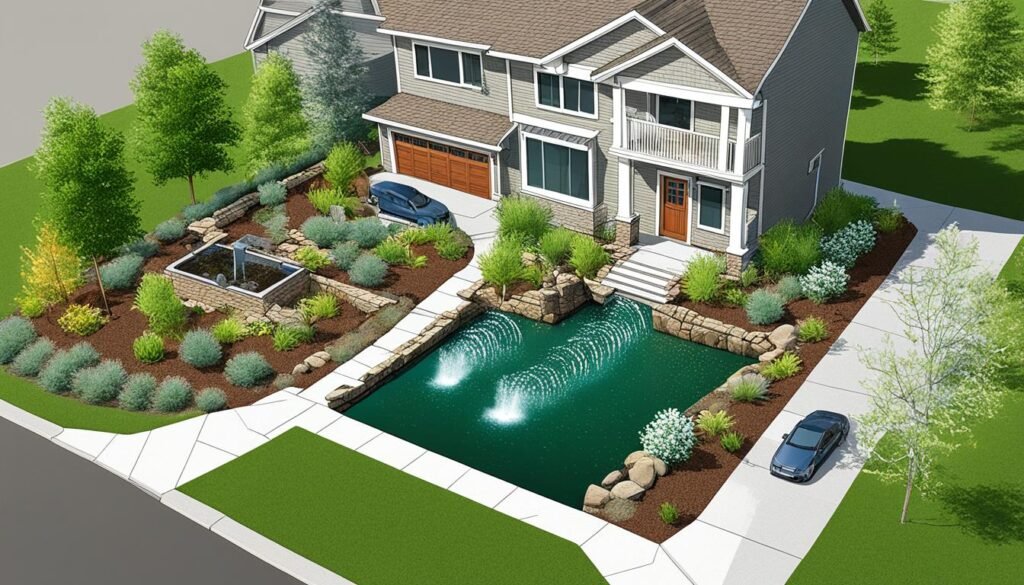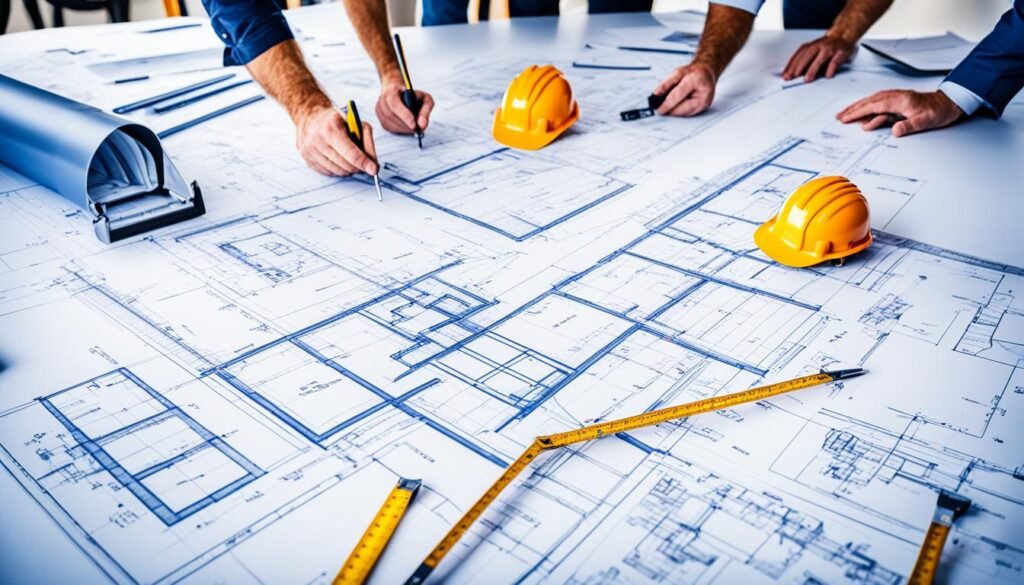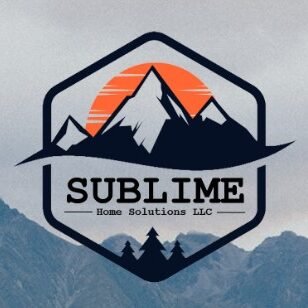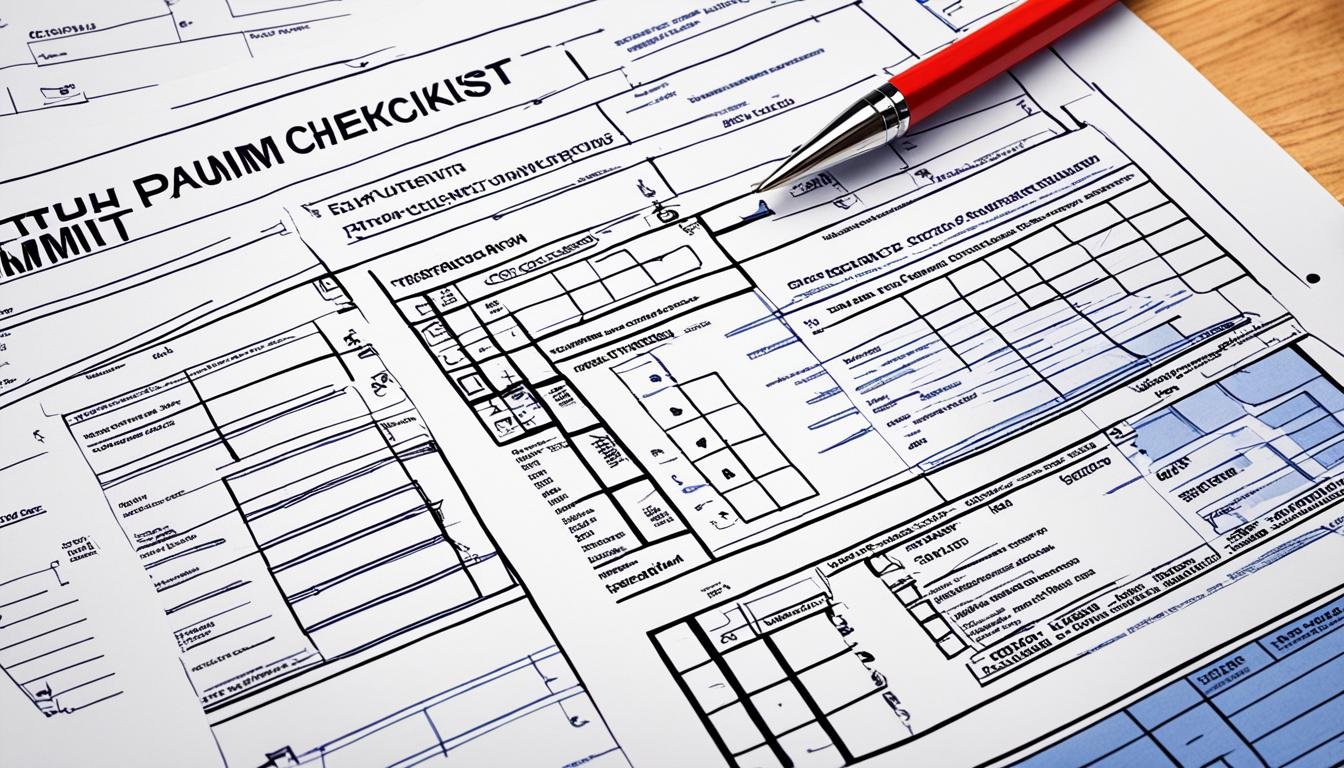Have you ever dreamed about building something amazing? Felt excited planning every little part? And couldn’t wait to see it finished? We get it. We understand the joy of turning dreams into reality. For that, getting the right permits is key.
Dealing with Utah’s building permit process can be tough. No one likes getting stuck in paperwork. That’s why we’ve put together a checklist to help. It guides you through everything. With it, you can tackle all the requirements and paperworks Utah asks for, making your dream project real.
We’re here to simplify getting a Utah building permit and handing in all needed papers. Ready to dive in? Let’s look at what you must know to get that all-important building permit.
Key Takeaways:
- Ensure a smoother, more efficient journey towards obtaining a Utah building permit by following our comprehensive checklist.
- From property details to fire protection requirements, water source and wastewater disposal, building plans, and the overall permit process – we’ve got you covered.
- Understand the crucial elements involved in securing a building permit and submit the required documentation to avoid delays or complications.
- Our checklist provides the guidance you need to navigate the complexities of the Utah building permit process successfully.
- Transform your construction dreams into reality by following our expert advice and securing the necessary building permits for your project.
Property and Landowner Information
Applying for a building permit in Utah means gathering important info about the property and its owner. This info helps meet zoning and architectural rules.
If you own the property, we need your name, address, phone, and email. That lets us contact you for updates or questions.
We also need the property’s legal description to confirm you own it. A tax notice or a recorded deed works as proof.
A plot plan is crucial for your application. It shows the layout with details like setbacks and utilities. It’s key for checking if your project is doable.
Don’t forget to check zoning rules and get needed approvals from committees or homeowner associations. These steps make sure your project fits the community’s guidelines. We advise getting these clearances before applying for your permit.
Also, give us clear directions to your property. It helps our inspectors during visits and inspections. Good directions make the review process smoother and quicker.
Getting a permit in Utah means paying attention to detail and following steps. With the right information and approvals, you help speed up the permit process.
| Owner Information | Owner’s Name, Address, Phone Number, Email Address |
|---|---|
| Proof of Ownership | Tax Notice or Recorded Deed |
| Plot Plan | Showing Setbacks, Driveway Access, Right-of-ways, and Utility Locations |
| Zoning Requirements | Verify and Obtain Necessary Approvals |
| Architectural Approval | Obtain Committee or Association Approval |
| Directions to Property | Mapped or Written Directions for Inspections |
Fire Protection and Wildland Urban Interface Code Review
Fire safety is something we take very seriously. That’s why having a fire protection plan is key when you apply for a building permit. We want to make sure your property is up to all fire safety standards. This keeps everyone in the community safe. But first, you need County Fire Warden approval.
“Fire protection plan: Check. County Fire Warden approval: Check. We’re on our way to a safer, more resilient property!”
To gain approval from the County Fire Warden, your fire protection plan must be reviewed carefully. This review checks if your property follows the county’s fire safety rules.
If you submit a fire protection plan, you might also need a site inspection. This is crucial to see if your fire safety measures will actually work. We want your plan to work in real life, not just look good on paper.
Wondering what to include in your fire protection plan? Well, it can vary. But, typically, you should think about:
- Fuel modification strategies for reducing wildfire risk
- Defensible space around buildings
- Fire-resistant building materials
- Planning for water sources and fire hydrants
- Emergency access routes
To make your fire protection plan complete and customized to your property, use the fire protection requirements checklist we’ve provided. It will help make sure you cover all necessary elements in your plan.
Getting the County Fire Warden’s approval is a big part of the permit process. Put in the effort to develop a strong fire protection plan that meets all the standards. It’s more than just checking off requirements—it’s making your property and community safer.
Water Source and Wastewater Disposal
Getting a building permit in Utah needs a proper water source and wastewater plan. At [Brand Name], we make sure your project is safe and follows the rules. Let’s look at what you need to keep in mind:
Onsite Wastewater Disposal Permit
To start, get an onsite wastewater disposal permit from the Tri-County Health Department. This permit checks that your project can manage wastewater right. It looks at how well your site can deal with waste and sets up the right systems.
Culinary Water Supply
You need proof like a letter for your culinary water supply. This shows you have clean and reliable water for drinking and cooking. The Water District or City/Town gives this to make sure your project has the water it needs.
Private Potable Water Systems
Projects with private potable water systems need the ok from the Tri-County Health Department. This check makes sure your water is clean and safe. It’s key for the health of everyone who will use the water.
New Well Permits
If you’re planning a new well, contact the Utah Division of Water Rights for a permit. You’ll need to test the water for safety. After passing, you must send the results to the Tri-County Health Department for your occupancy certificate.
Following these water and waste rules is more than just legal. It helps the planet and your community’s health too.
| Permit Type | Issuing Authority | Contact Information |
|---|---|---|
| Onsite Wastewater Disposal Permit | Tri-County Health Department | Visit [Website URL] or call [Phone Number] |
| Culinary Water Supply | Water District or City/Town | Contact your local Water District or City/Town office for requirements |
| Private Potable Water Systems | Tri-County Health Department | Visit [Website URL] or call [Phone Number] |
| New Well Permits | Utah Division of Water Rights | Visit [Website URL] or call [Phone Number] |
We at [Brand Name] are here to make the permit process easy for you. Our team knows exactly what you need and will help you get your permits. Reach out to us to move your project forward!

Building Plans and Contractors
To get a building permit, you need complete plans in PDF format. These include truss specs and HVAC details. All this ensures you meet regulations.
Finding good contractors can be tough. It helps to list them with their licenses and contact info. This makes things clear and easier for everyone.
As an owner/builder, you must fill and notarize a special form. It shows you’re in charge and will follow all building rules.
Sometimes, the Building Official might ask for more engineering info. You should be ready to give any extra details needed for your project.
Money matters too. There’s a deposit for plan reviews to cover review costs and inspections. The amount depends on how big your project is.
There’s also a building permit fee based on your project’s size and standard costs. We help figure out your specific fee to fit your budget.
The Value of Comprehensive Planning
“A well-prepared plan and a team of reliable contractors are the foundation of any successful construction project.” –Utah Builders Association
Good planning makes everything run smoother. With full plans, HVAC details, and a solid contractor list, you’re on track. All this planning helps avoid delays and keeps the permit process smooth.
Building codes are there to keep buildings safe. If you take them seriously and work with pros, it pays off. You’ll have a stronger, safer project in the end.
Our team is ready to help and advise you. With us, you can make your building dream a reality.

| Documents | Requirements |
|---|---|
| Building Plans | Complete set in PDF format |
| Preliminary Engineered Truss Specifications | Included in the plans |
| HVAC Calculations | Provided along with equipment specifications |
| List of Contractors | License numbers, addresses, phone numbers, and business licenses |
| Owner/Builder Form | Completed and notarized if applicable |
| Other Engineering Requirements | As specified by the Building Official |
| Plan Review Deposit | Based on the scope and size of the project |
| Building Permit Fee | Based on project square footage and national average construction cost per square foot |
Helpful Phone Numbers
Getting a building permit in Duchesne County is easier with the right contacts. Here are some crucial phone numbers for various departments. They will help you through the process:
Duchesne County Departments
- Department of Building Safety: (555) 123-4567
- Planning & Zoning: (555) 987-6543
- Public Works/Roads: (555) 567-8901
- Fire & Emergency Management: (555) 234-5678
Town and City Offices
- Town Office: (555) 876-5432
- City Hall: (555) 321-0987
State Departments
- Utah Department of Transportation (UDOT): (555) 789-0123
- Utah Division of Water Rights: (555) 210-9876
Utility Districts
- Moon Lake Electric: (555) 654-3210
- Water/Sewer Districts: (555) 432-1098
Keep these phone numbers handy to quickly solve any issues during the permit process. Remember, good communication is the key to your project’s success!
Building Permit Process
Getting a building permit in Duchesne County means you have to submit many documents. This ensures everything meets regulations.
Owner’s Information
It’s important to give correct details about the property owner. This includes their name, address, phone number, and email. These details help with important communications.
Legal Description and Proof of Property Ownership
You need to provide a legal description of the property. You can get this from the county assessor’s office or the property deed. Also, show proof you own the property, like a tax notice or recorded deed.
Site Plan
A detailed site plan is also needed. This plan should show setbacks, utility locations, and other key details. It helps spot any issues early and ensures the project meets zoning laws.
Building Plans
Bring a complete set of building plans in PDF format. These should include architectural and structural drawings. Good plans make the review process easier.
Thermal Envelope Compliance
Show how your project meets thermal envelope requirements. Share calculations, specs, and insulation plans. This confirms your building will be energy efficient.
Gas Line Diagram
A gas line layout diagram is also needed. This shows how gas lines run in the building. It’s crucial for safety and proper gas use.
Additional Permits
Some projects may need extra permits for things like septic tanks or wells. Include all required permits and documents. This helps avoid delays.
Submitting all these documents properly can help you get your permit faster. This makes your Duchesne County building project go smoothly.
Conclusion
Building your dream home in Utah is both exciting and challenging. But, with our essential building permit checklist, you’re set to confidently handle the Utah building permit process.
Our checklist starts with collecting property details and goes through fire protection and water regulations. Though it may seem tough, following our steps and providing the right docs will make things smoother.
With the right info, getting a Utah building permit is simpler. Our checklist gives you the knowledge to confidently take each step. So, dive in, and make your construction dream come true in Utah!
FAQ
What information do I need to provide about the property and landowner?
What are the fire protection requirements for obtaining a building permit in Utah?
How do I obtain a water source and wastewater disposal permit for a building permit in Utah?
What documents do I need to submit for building plans and contractors?
Who should I contact for assistance with the building permit process in Utah?
What documents should I submit for the building permit process?
How can this building permit checklist help me navigate the Utah building permit process?
Source Links
- https://sslc.gov/215/Building-Permits
- https://cms9files.revize.com/grantsvilleut/Document_Center/Department/Building Department/Residential building submittal checklist2..pdf
- https://www.duchesne.utah.gov/wp-content/uploads/2022/01/Permit-Packet-Jan-2022.pdf


